Photography Differences: What Sets Cameras and Styles Apart
If you’ve ever wondered why two photographers can capture the same scene and end up with completely different pictures, you’re in the right spot. The answer lies in the many choices we make: the type of camera, the medium, the lighting, even the way we frame a shot. Below you’ll get the most common differences broken down so you can pick the gear and approach that fits your style.
DSLR vs Mirrorless: The Core Contrast
DSLRs have been the workhorse for decades. They use a mirror to bounce light up to an optical viewfinder, which gives a clear, lag‑free view of what you’ll capture. Mirrorless cameras ditch that mirror, sending the light straight to a sensor and showing you a digital preview on the back screen. Because there’s no mirror, mirrorless bodies are often smaller, lighter, and quieter – great for travel or street shoots where you don’t want to draw attention.
Performance‑wise, modern mirrorless models match or beat DSLRs on autofocus speed, especially for video. DSLRs still win on battery life; the optical viewfinder doesn’t need power the way an LCD does. If you shoot a lot of events and need long sessions without swapping batteries, a DSLR might feel more reliable.
Price can also tip the scales. Entry‑level DSLRs are usually cheaper, while high‑end mirrorless units can get pricey fast. Think about how much you’ll actually use each feature before deciding.
Film vs Digital: Why It Still Matters
Digital cameras dominate because they’re instant, cheap to run, and easy to edit. Yet film still holds a special place. Film captures light in a chemical process, giving a distinct grain and colour rendition that many say feels more “organic.” It forces you to slow down – you have a limited number of exposures, so you think before you click.
Digital sensors, on the other hand, deliver higher ISO performance, meaning you can shoot in low light without the grain you’d get from high‑speed film. The ability to review images on the spot also speeds up learning; you can see what works and adjust right away.
Cost is a major factor. A single roll of film might cost the same as a few hundred megabytes of memory cards, and you’ll need to factor in processing and scanning. Digital eliminates that recurring expense but requires a good computer and software to get the most out of raw files.
Choosing between them often comes down to the look you want and how much you enjoy the process. Some photographers even blend both: shoot digital for most work, then switch to film for a specific project that needs that vintage vibe.
Beyond gear, lighting choices create huge differences. Natural light gives soft, flattering tones but is unpredictable. Studio lighting lets you shape shadows precisely, though it needs equipment and space. Understanding when to use each will instantly lift your work.
Finally, composition rules like the rule of thirds, leading lines, and negative space apply regardless of camera type. Master these basics, then experiment with different gear to see how each tool influences the final image. The more you compare side by side, the clearer the photography differences become, and the faster you’ll develop your own visual voice.

20 Feb 2025
Art photography and fine art photography may sound similar, but they have distinct characteristics. This article explores the differences between the two, highlighting how art photography is often driven by commercial and aesthetic considerations, while fine art photography emphasizes the personal vision of the artist. Discover unique insights and useful tips to identify and appreciate each form. Whether you're a budding photographer or a seasoned connoisseur, understanding these differences can enhance your appreciation of photographic art.
Continue reading...
